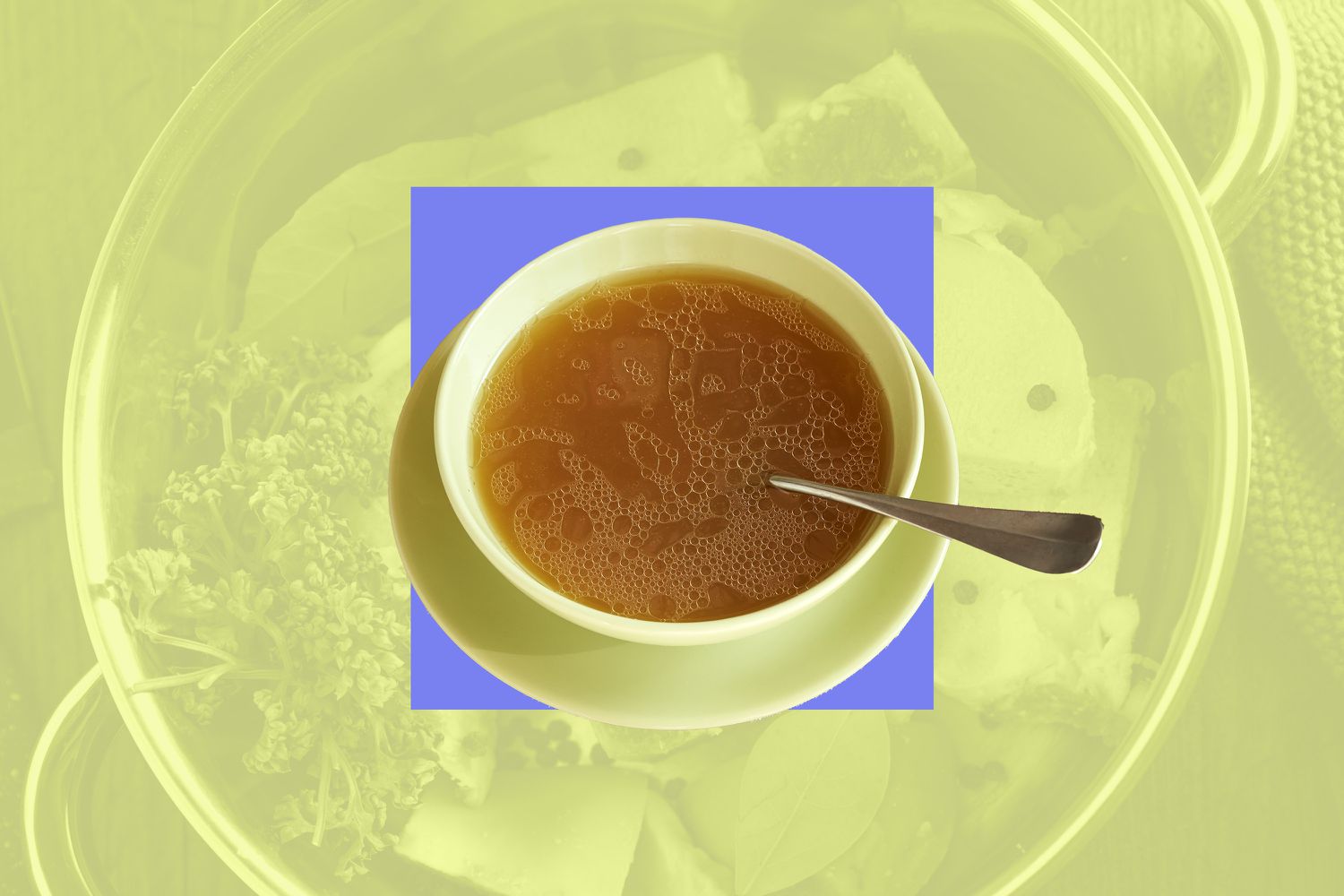The Advantages and Things to Keep in Mind About Bone Broth

Bone broth, a hot, salty beverage, has gained popularity in recent years due to its numerous alleged health benefits, such as boosting immunity, aiding digestion, detoxifying the liver, and providing arthritis relief.
Is this fashionable trend as good as it's cooked up to be? In this article, we will discuss how bone broth is made, its speculated health benefits, and any potentially adverse effects it may have. Continue reading to determine whether you should include bone broth in your daily diet.
Bone broth has been a staple food for centuries, with multiple variations existing globally. In the 12th century, bone broth was nicknamed 'Jewish penicillin' when physician Maimonides praised it as both a nourishing food and a medicine.
Many Asian cultures have variations of 'Long Life Broth,' a mix of whole poultry and fresh or dried shellfish, including bones, feet, and shells. In the Caribbean, it is known as 'cow foot soup,' a collagen-rich meal consumed either as a hearty breakfast or for treating various ailments. In Korea, they have seolleongtang, and in Japan, tonkotsu, both of which are rich, creamy broths made from bone marrow fat and myoglobin.
In the U.S., bone broth is usually made from roasted bones—occasionally with attached meat—and vegetables. It's commonly cooked for over 24 hours, then strained and seasoned. Bone broth sits somewhere between a broth and a stock.
For comparison, broth is produced by simmering vegetables, meat, herbs, and spices in a liquid, optionally with bones, for 45 minutes to two hours, then strained and seasoned. Alternatively, stock is made by simmering vegetables (commonly carrots, onions, and celery) with animal bones (such as chicken, beef, or fish), occasionally with meat, for four to six hours, then strained.
Many people believe that the extended cooking time of bone broth enhances its health benefits, particularly because collagen, amino acids, and minerals are extracted into the liquid during this time.
Given the variance in bone broth recipes, the nutritional composition can differ between homemade and store-bought versions. The USDA Nutrient Database does not provide information for bone broth, likely due to the challenge of determining exact numbers based on recipe variations. However, food companies do offer bone broth nutrition information on their packaging.
Despite some assertions, the quantity of vitamins and minerals in packaged bone broth is not significant. Other nutrients found in bone broth include collagen, glycine, proline, gelatin, and glutamine.
According to Leslie Bonci, MPH, RDN, CSSD, LDN, FAND owner of Active Eating Advice by Leslie Bonci, Inc, being made with animal bones makes bone broth a rich source of protein, particularly collagen. "Slow cooking breaks down the collagen, so it has a higher collagen and protein content than traditional broth," she says.
Bone broth is also an excellent source of glycine and proline—two amino acids that are produced during collagen digestion. Both of these amino acids are prevalent in the collagen found in connective tissue, cartilage, tendons, and bones. Some studies suggest that people may not produce enough of these amino acids for optimal health. Glutamine and glycine can also be found in bone broth.
While your body typically produces enough glutamine, sometimes it may need more—like when you're sick. Additionally, your body requires glycine to make collagen. Bone broth is an excellent source of both.
According to Wendy Bazilian, DrPH, RDN author of the Eat Clean, Stay Lean series and owner of Bazilian's Health in San Diego, California, the amount of calcium in bone broth increases with the cooking time, particularly in an acidic environment. "This is why adding an acid (e.g. apple cider vinegar) to the stock is essential to maximize the mineral extraction during cooking. The acid (vinegar) helps pull the nutrients (minerals and others) from the bone and marrow and into the broth," she explains.
Other nutrients found in bone broth include magnesium, silicon, sulfur, phosphorus, glucosamine sulfate, and chondroitin. "These minerals are extracted from the bones in part due to the use of a vinegar solution before cooking," she adds.
Given the variety of nutrients found in bone broth, some research has been conducted concerning specific health conditions. Some of these conditions include gut health, immune support, joint health, and skin health. Let's take a closer look at some of the potential health benefits.
Research indicates that glutamine, a component of bone broth, may contribute to intestinal health by aiding in the maintenance of the gut barrier function and the prevention of leaky gut. Nonetheless, conclusive evidence supporting the health benefits of bone broth, particularly for bone health, remains scarce. The absorption, metabolism, and utilization of collagen, another ingredient in bone broth, are still topics of ongoing research.
Despite the limited evidence, bone broth is often praised for its potential immune-boosting properties. Glutamine, for instance, is used by activated immune cells. As Melissa Mitri, MS, RD, a nutrition writer and owner of Melissa Mitri Nutrition, mentions, 'Bone broth, due to its high nutritional content, possesses anti-inflammatory properties which may help in reducing inflammation in the body.'
According to Bazilian, bone broth has been utilized as a remedial concoction in Traditional Medicine for centuries. It contains gelatin, which has anti-infection and anti-inflammatory properties. Zinc and other nutrients present in bone broth are associated with enhanced immunity and play a key role in preserving muscle tissue, producing enzymes and hormones, and supporting cell formation crucial for a healthy immune system.
Proper hydration is essential for optimal immune system function. Bone broth can assist in meeting daily fluid needs. The consumption of fluids aids in nutrient transportation to cells for energy and growth, and bone broth is a prime example of a hydrating fluid.
Joint health may also potentially benefit from the intake of bone broth. This is mainly due to the collagen present in it. However, studies of collagen related to osteoarthritis have largely centered on supplements rather than bone broth.
Despite the speculation, the consumption of bone broth for skin health has yet to be thoroughly researched. Bone broth improves the taste of dishes and helps maintain hydration while being easy to digest. Nevertheless, it does come with drawbacks such as being expensive, lacking in vegetables, and not being a significant source of protein.
Bonci adds that collagen is not a high-quality or complete protein. Bone broth's protein intake optimization is thus questionable. Moreover, some researchers note that bone broth may contain heavy metals like lead, but this is a subject of debate.
Lastly, homemade bone broth must be handled with care to avoid contamination and the growth of harmful microorganisms. For store-bought bone broth, it is advised to follow the product's storage instructions.
If you choose to incorporate bone broth into your regular eating plan, there are a number of ways to do so. A few suggestions from Mitri include:
Other ways to add bone broth to your balanced diet include using it in soups and stews. Bonci recommends amping up the nutrition of bone broth by adding pieces of chicken and vegetables and even rice or pasta for a one-pot balanced soup. You can also swap it in recipes that call for regular broth or stock in stews or sauces.
If you are looking for store-bought bone broths, dietitians recommend the following products. But be sure to read the labels to ensure they align with your eating goals, specifically with regard to sodium.
For folks who choose to follow a vegetarian or vegan diet, consuming meat or poultry-based bone broth is not possible. However, there are bone broths made from fish shells and bones that a vegetarian can consume.
Mitri also suggests vegan bone broths, which are made from seaweed and mushrooms as the main ingredient, with added vegetables like onions, herbs, and spices. However, Mitri points out that vegan bone broth doesn't contain collagen (as collagen is only found in animals), but it does contain nutrients like vitamin C that help to promote collagen production in the body.
Several brands that sell vegetarian or vegan-friendly bone broth options include:
You can also make your own bone broth at home. A slow cooker can be used in this Slow Cooker Beef Bone Broth recipe courtesy of Chrissy Carroll, RD owner of Snacking in Sneakers. But, we also have included two additional recipes for homemade bone broth below.
- Klean Collagen + C Bone Broth
- Bazilian's Chicken, Turkey, Beef, or Fish Bone Broth
There are several ingredients in bone broth that folks with food allergies should be aware of. Bone broth may contain fish or shellfish and sometimes dairy. Read the nutrition facts label if you have food allergies to ensure the broth is safe for you to consume.
In addition, bone broth contains amino acids and minerals that can interact with certain medications, specifically blood thinners. Additionally, homemade bone broth can have food safety issues due to the long cooking process. Folks who are pregnant or nursing, young children, older individuals, and people with a weakened immune system can specifically be affected if the bone broth doesn't follow food safety guidelines.
If you take a blood thinner, are planning to undergo a surgical procedure, or have a weaker immune system, speak with a healthcare provider before consuming bone broth.
Bone broth certainly provides a variety of good-for-you nutrients, but on its own, it's not a complete meal nor is it a magic formula to good health. That said, bone broth can easily be incorporated into a well-balanced, nutritious diet using simple swaps in your kitchen.
To save food dollars, make your own bone broth (or a double batch!) and freeze half for later. There are also various brands that sell good quality bone broth in liquid or powder form that you can choose to buy.




